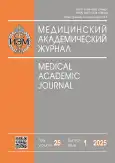Investigation of the structure of the nuclei of the Ehrlich adenocarcinoma cell line with a radioresistant phenotype
- Authors: Burdakov V.S.1, Kulakov I.A.1, Ivanova L.A.1, Gorshkova Y.E.2, Kopitsa G.P.1,3, Lebedev D.V.1, Bogdanov A.A.4, Verlov N.A.1
-
Affiliations:
- Konstantinov Petersburg Nuclear Physics Institute of the Kurchatov Institute
- Joint Institute for Nuclear Research
- Grebenshchikov Institute of Silicate Chemistry of the Konstantinov Petersburg Nuclear Physics Institute of the Kurchatov Institute
- Napalkov Saint Petersburg Clinical Scientific and Practical Center of Specialized Types of Medical Care (Oncological)
- Issue: Vol 25, No 1 (2025)
- Pages: 54-61
- Section: Original research
- Published: 31.05.2025
- URL: https://journals.eco-vector.com/MAJ/article/view/635503
- DOI: https://doi.org/10.17816/MAJ635503
- EDN: https://elibrary.ru/LCXCJK
- ID: 635503
Cite item
Abstract
BACKGROUND: One of the obstacles in successful radiation therapy of malignant tumors is the emergence of cell subpopulation that have lower radiosensitivity than the original tumor. Use of fractionated irradiation in this case leads to a possibility of the radioresistant cells to substitute the initial cell population. We assume that changes in epigenetic profile of a cell affect chromatin packaging in the cell nucleus. This in turn represents changes leading to formation of the radioresistant phenotype.
AIM: The aim is to study the structure of nuclei of a subpopulation of Ehrlich adenocarcinoma cells with a radioresistant phenotype.
METHODS: In the present study the cells of ascitic Erlich adenocarcinoma have been sequentially irradiated in the PX-γ-30 (source is 60Co, dose output is 0.87 Gy/min). Then the cells have been inoculated into female outbred mice ICR (CD-1). Irradiation of the original population of Erlich adenocarcinoma showed that cells were losing an ability to transplantation after a dose of 20 Gy. In the series of irradiations with a gradual dose increase (from 10 to 40 Gy) there was obtained a cell subpopulation that retains an ability to transplantation after a dose of 40 Gy. The original and radioresistant cell subpopulations were tested for sensitivity to ionizing radiation. Nuclei were collected from these cells for further structure investigation with the method of small angle X-ray scattering (SAXS).
RESULTS: Analysis of SAXS data of the nuclei showed no significant changes in nucleus structures of Erlich adenocarcinoma initial cells that survived irradiation with doses of 20 and 30 Gy. At the same time, Erlich adenocarcinoma cells that survived irradiation with a dose of 40 Gy demonstrated abnormally low fractal dimension on mass fractal mode (in a size of 40–200 nm).
CONCLUSION: Observations of chromatin packing variations well conform with data obtained by biological characterization of researched samples and appear as a crucial aspect of understanding mechanisms of radioresistance occurrence.
Full Text
About the authors
Vladimir S. Burdakov
Konstantinov Petersburg Nuclear Physics Institute of the Kurchatov Institute
Email: burdakov_na@pnpi.nrcki.ru
ORCID iD: 0000-0001-6025-7367
Junior Researcher
Russian Federation, GatchinaIgnaty A. Kulakov
Konstantinov Petersburg Nuclear Physics Institute of the Kurchatov Institute
Author for correspondence.
Email: kulakov_ia@pnpi.nrcki.ru
ORCID iD: 0009-0003-5952-4773
SPIN-code: 6895-7452
Senior Laboratory Assistant
Russian Federation, GatchinaLyubov A. Ivanova
Konstantinov Petersburg Nuclear Physics Institute of the Kurchatov Institute
Email: ivanova_la@pnpi.nrcki.ru
ORCID iD: 0000-0002-3341-4344
Junior Researcher
Russian Federation, GatchinaYulia E. Gorshkova
Joint Institute for Nuclear Research
Email: gorshk@nf.jinr.ru
ORCID iD: 0000-0002-5016-1553
SPIN-code: 6493-3711
Cand. Sci. (Physics and Mathematics), Senior Researcher
Russian Federation, DubnaGennady P. Kopitsa
Konstantinov Petersburg Nuclear Physics Institute of the Kurchatov Institute; Grebenshchikov Institute of Silicate Chemistry of the Konstantinov Petersburg Nuclear Physics Institute of the Kurchatov Institute
Email: kopitsa_gp@pnpi.nrcki.ru
ORCID iD: 0000-0002-0525-2480
SPIN-code: 3176-8490
Senior Researcher; Senior Researcher
Russian Federation, Gatchina; Saint PetersburgDmitry V. Lebedev
Konstantinov Petersburg Nuclear Physics Institute of the Kurchatov Institute
Email: Lebedev_dv@pnpi.nrcki.ru
ORCID iD: 0000-0003-4313-9953
SPIN-code: 7937-5595
Cand. Sci. (Physics and Mathematics), Deputy Head of Science
Russian Federation, GatchinaAlexey A. Bogdanov
Napalkov Saint Petersburg Clinical Scientific and Practical Center of Specialized Types of Medical Care (Oncological)
Email: a.bogdanov@oncocentre.ru
ORCID iD: 0000-0002-7887-4635
SPIN-code: 5625-8391
Cand. Sci. (Physics and Mathematics), Deputy Director for Scientific Work
Russian Federation, Saint PetersburgNikolay A. Verlov
Konstantinov Petersburg Nuclear Physics Institute of the Kurchatov Institute
Email: verlov_na@pnpi.nrcki.ru
ORCID iD: 0000-0002-3756-0701
SPIN-code: 8787-7492
Cand. Sci. (Biology), Head of the Resource Center of Department of Molecular and Radiation Biophysics
Russian Federation, GatchinaReferences
- Bernier J, Hall EJ, Giaccia A. Radiation oncology: a century of achievements. Nat Rev Cancer. 2004;4(9):737–747. doi: 10.1038/nrc1451
- Windholz F. Problems of acquired radioresistance of cancer; adaptation of tumor cells. Radiology. 1947;48(4):398–404. doi: 10.1148/48.4.398
- Busato F, Khouzai BE, Mognato M. Biological mechanisms to reduce radioresistance and increase the efficacy of radiotherapy: state of the art. IJMS. 2022:23(18):10211. doi: 10.3390/ijms231810211
- Fang M, Marta GN. Hypofractionated and hyper-hypofractionated radiation therapy in postoperative breast cancer treatment. Rev Assoc Med Bras (1992). 2020;66(9):1301–1306. doi: 10.1590/1806-9282.66.9.1301
- Raveendran C, Meloot SS, Yadev I. Survival outcomes of post-mastectomy breast cancer patients treated with hypofractionated radiation treatment compared to conventional fractionation – a retrospective cohort study. Gulf J Oncolog. 2023;1(42):26–34.
- Rivera S, Hannoun-Lévi J-M. Hypofractionated radiation therapy for invasive breast cancer: From moderate to extreme protocols. Cancer Radiothér. 2019;23(8):874–882. doi: 10.1016/j.canrad.2019.09.002
- Dagogo-Jack I, Shaw AT. Tumour heterogeneity and resistance to cancer therapies. Nat Rev Clin Oncol. 2018;15(2):81–94. doi: 10.1038/nrclinonc.2017.166
- Falk M, Lukášová E, Kozubek S. Chromatin structure influences the sensitivity of DNA to gamma-radiation. Biochim Biophys Acta. 2008;1783(12):2398–2414. doi: 10.1016/j.bbamcr.2008.07.010
- Hawkins RB. The influence of concentration of DNA on the radiosensitivity of mammalian cells. Int J Radiat Oncol Biol Phys. 2005;63(2):529–535. doi: 10.1016/j.ijrobp.2005.05.055
- Levantino M, Yorke BA, Monteiro DC, et al. Using synchrotrons and XFELs for time-resolved X-ray crystallography and solution scattering experiments on biomolecules. Curr Opin Struct Biol. 2015;35:41–48. doi: 10.1016/j.sbi.2015.07.017
- Lebedev DV, Filatov MV, Kuklin AI, et al. Fractal nature of chromatin organization in interphase chicken erythrocyte nuclei: DNA structure exhibits biphasic fractal properties. FEBS Lett. 2005;579(6):1465–1468. doi: 10.1016/j.febslet.2005.01.052
- Isaev-Ivanov VV, Lebedev DV, Lauter H, et al. Comparative analysis of the nucleosome structure of cell nuclei by small-angle neutron scattering. Phys Solid State. 2010;52(5):1063–1073. doi: 10.1134/S1063783410050379
- Lebedev DV, Zabrodskaya YA, Pipich V, et al. Effect of alpha-lactalbumin and lactoferrin oleic acid complexes on chromatin structural organization. Biochem Biophys Res Commun. 2019;520(1):136–139. doi: 10.1016/j.bbrc.2019.09.116
Supplementary files









